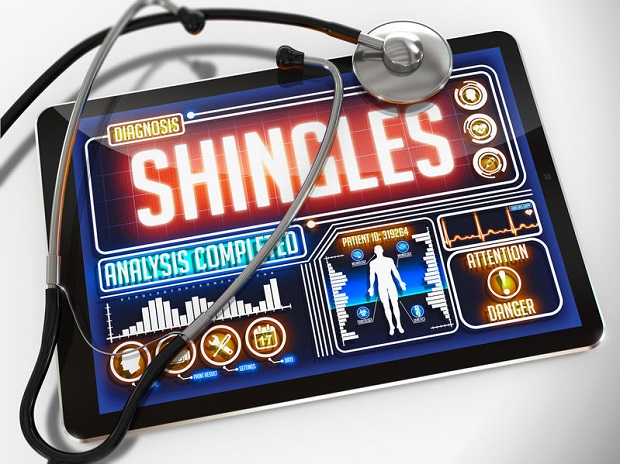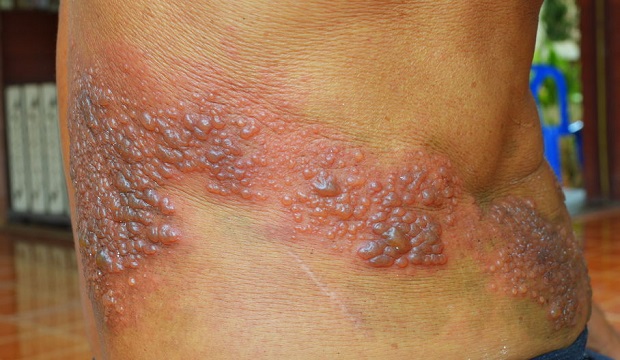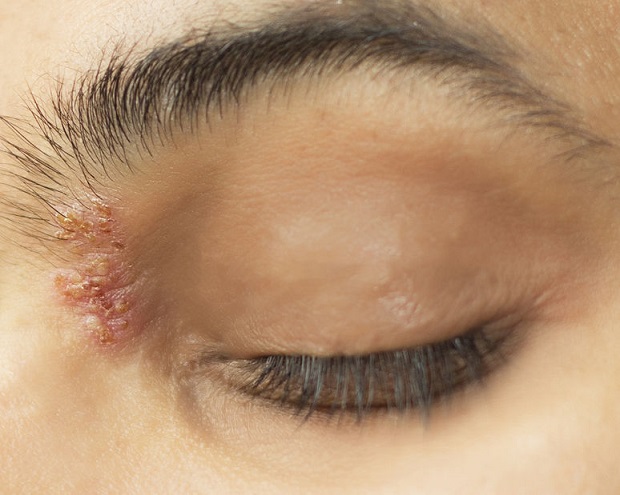
Where Do Shingles Appear on the Body?
Though shingles can attack any part of the body, the virus is most often seen on the chest and face. [1]
Jump Ahead
- Shingles Attack Nerve Endings
- Thoracic Herpes Zoster and Intercostal Nerves
- Ophthalmic Herpes Zoster and Cranial Nerves
- Herpes Zoster Incidence Rates
- Resources
Shingles Attack Nerve Endings
Herpes zoster, more commonly known as shingles, is caused by the reactivation of the varicella-zoster virus that causes chickenpox. Following a chickenpox infection, the virus lays dormant in the cranial and spinal nerves until the body’s immunity to the virus decreases due to age or immunosuppression. Once the virus reactivates, it travels along the distribution of sensory nerves to the skin, where it presents as a painful rash. This distribution pattern is called a dermatome. [2]
The most common nerves affected by shingles are cranial nerves and intercostal nerves. [3]
Thoracic Herpes Zoster and Intercostal Nerves
The most common form of shingles seen clinically is thoracic herpes zoster, which appears on the rib cage region of the body. Here the herpes zoster virus attacks the intercostal nerves, that is, those nerves situated between the ribs. [4]
These shingles will often appear, wrapping around the torso on one side.

Ophthalmic Herpes Zoster and Cranial Nerves
The cranial nerve most affected by herpes zoster is the fifth cranial nerve, particularly the ophthalmic nerve branch. When this nerve cluster is affected, it creates a condition known as ophthalmic herpes zoster. [5]
Ophthalmic herpes zoster is an instance in which the shingles virus attacks the fifth cranial nerve, which is shared by the eye and orbit. [6] 1 out of 100 people will contract the virus in this location. Without antiviral treatment, half of those who contract shingles in this location will develop various eye disorders, some of which can affect vision and can even lead to vision loss. [7]
Ophthalmic herpes zoster represents 10-20% of all shingles cases. [8]

Herpes Zoster Incident Rate
An estimated one in three people who have had chickenpox will get shingles sometime in their lives. [9] The good news is the recurrence of herpes zoster is not common, afflicting 6-14% of those who have had it before. [10]
Resources
- [1] Devor, Marshall. “Rethinking the causes of pain in herpes zoster and post herpetic neuralgia: the ectopic pacemaker hypothesis.” Pain Reports. 2018. Vol. 6, No. 6, pp: 702.
- [2] Sampathkumar, Priya. “Herpes Zoster (Shingles) and Postherpetic Neuralgia.” Mayo Clinic Proceedings. 2009. Vol. 84, No. 3, pp: 274-280.
- [3] Cukic, Vesna. “The Uncommon Localization of Herpes Zoster.” Medical Archives. 2016. Vol. 70, No. 1, pp: 72-75
- [4] B. K. Kleinschmidt-DeMasters and Donald H. Gilden. “Varicella-Zoster Virus Infections of the Nervous System.” Archives of Pathology & Laboratory Medicine. 2001, Vol. 125, No. 6, pp. 770-780.
- [5] Shaikh, Saad. “Evaluation and Management of Herpes Zoster Ophthalmicus.” American Family Physician. 2002. Vol. 66, No. 9, pp: 1723-1730.
- [6] Cason, John. Et al. “Herpes Zoster Ophthalmicus.” American Academy of Ophthalmology.
- [7] [8] [10] Opstelten, Wim. “Managing ophthalmic herpes zoster in primary care.” British Medical Journal. 2005. Vol. 331, No. 7509, pp: 147-151.
- [9] Centers for Disease Control – “Shingles (Herpes Zoster).”
DISCLAIMER: THIS WEBSITE DOES NOT PROVIDE MEDICAL ADVICE
The information, including but not limited to text, graphics, images, and other material on this website, is for informational purposes only. No material on this site is intended to be a substitute for professional medical advice, diagnosis, or treatment. Always seek the advice of your physician or other qualified healthcare providers with any questions you may have regarding a medical condition or treatment before undertaking a new healthcare regimen, and never disregard professional medical advice or delay in seeking it because of something you have read on this or any other website.





